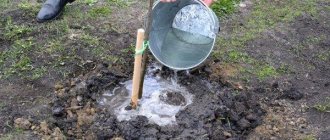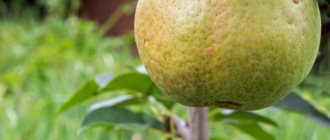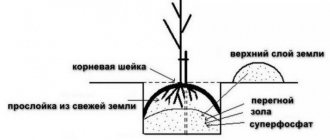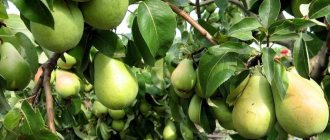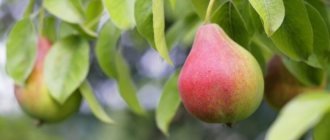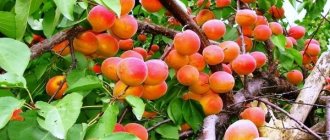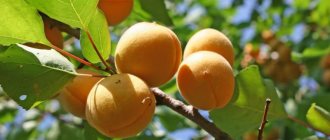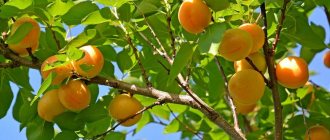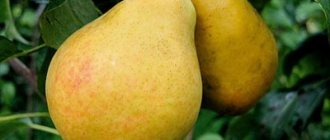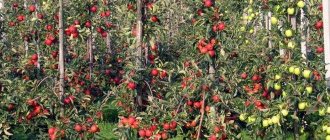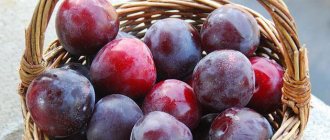History of the Cathedral pear variety
The Cathedral pear variety was bred by breeders in 1990. Today this is one of the most popular species in the central part of Russia, Ukraine, as well as in some regions of Belarus. Its great demand is due to its good characteristics.
The variety was obtained from two hybrids. The first of them is a mixture of “Theme” and “Forest Beauty”, the second is “Duchess” and “Forest Beauty”. Cathedral was bred as a summer variety. In this case, the time of harvest ripening depends on the place where the tree is grown and can be observed earlier or later, with a shift of up to 14 days.
The flowers are large, with oval petals of snow-white color.
Main characteristics
The trees are usually medium in size, and the food is formed in the form of a regular cone. The density is moderate. The main branches are straight, the tips are curved upward, the arrangement is not too frequent. The bark has a gray tint; if you touch it, it is smooth.
Most of the fruits appear on simple ringlets; some also appear on annual shoots.
The shoots are moderate in size, straight and have a small fluff. They are reddish-brown in color. The buds are large, cone-shaped, pubescent.
The foliage is oval in shape and light green. There are small notches along the edges. There is no gun, the plate is completely smooth to the touch.
The flowers are large, cup-shaped, and have white petals.
Description of the variety
Also check out these articles
- Kalanchoe flower
- The best varieties of tomatoes for greenhouses
- Diseases of pears and the fight against them
- How to store garlic in an apartment in winter
The appearance of the Cathedral pear largely depends on the climate in which it grows. The tree can grow up to 4 meters in the middle regions, up to 3.5 meters in the north and about 5 meters in the southern regions. The crown is moderately dense, cone-shaped. It has a smooth trunk and is gray in color. The buds are always slightly pubescent. The leaves are heterogeneous, both large and medium ones can be found. The shape is oval, with a glossy plate, and there are ciliated notches along the edge. Flowering occurs in early May. The flowers are large, with oval petals of snow-white color.
The fruits are small, 120 g on average. The skin is delicate, not dense, shiny, there are visible subcutaneous points. At technical maturity, the fruits are yellow-green, and at consumer ripeness they are yellow with a red side. The pulp is white, dense, with a fine-grained structure. The taste is sweet and sour, harmonious. The aroma is light, pear.
Important!
If a pear grows in shade or partial shade, it will not be able to ripen juicy, sweet fruits. At best the taste will be sour, but usually it is bland when grown like this.
The pulp is white, dense, with a fine-grained structure
Diseases and pests
Cathedral pear, grown in compliance with all agrotechnical rules, is rarely subject to fungal diseases and is especially resistant to sooty fungus and scab. But if the tree is not properly cared for, it weakens and becomes more susceptible to disease.
Diseases of the Cathedral pear - table
| Disease | Symptoms | Prevention | Treatment |
| Rust | The leaves are covered with pronounced orange spots. They dry out and fall off. |
|
|
| Moniliosis, or fruit rot | The fruits are covered with brown spots. Soon growths with fungal spores inside form on them. The pulp becomes loose and tastes unpleasant. |
|
|
| Stem rot or cystoporosis | First of all, the disease affects old and weakened pears that have not been properly cared for, have sunburn or have been damaged by frost. The bark affected by cystoporosis becomes dark red in color, and the tree gradually dries out. |
|
|
| Powdery mildew | The leaves, shoots and flowers of the pear are covered with a white coating - fungal spores. The affected parts become deformed and the ovary falls off. | All fallen leaves are collected around the tree and destroyed. | Before budding and after flowering, treat the pear with Fundazol or Sulfite. Prepare the solution according to the instructions. |
Pear diseases in the photo
A tree suffering from cystosporosis gradually dries out
Pear leaves covered with powdery mildew become deformed
Red spots on the leaves are a sign of rust
Pear fruit affected by moniliosis rots
Pests and measures to combat them - table
| Pest | Symptoms | Prevention | Control measures |
| Green apple aphid | Leaves and apical shoots are damaged. They curl and dry out. |
|
|
| leaf roller | The caterpillar infects pear leaves. They curl into a tube and are covered with cobwebs. |
| Before budding, treat the pear with Ditox, Zolon or Tagore (10 ml per 10 liters of water). The solution consumption rate is from 2 to 5 liters per tree, depending on the age. |
| Gall mite | It feeds on juice, sucking it from the kidneys. | Cut off and destroy affected branches. |
|
| Pear sucker | It feeds on intercellular sap, which causes buds, buds, and leaves to wrinkle and fall off. |
|
|
Photo gallery: how to recognize a pest
The leaf in which the gall mite lives is easy to distinguish visually
By feeding on intercellular juice, the pear borer weakens the plant
Pear leaves affected by the leaf roller curl
Aphids prefer young leaves and shoots
Characteristics of Cathedral pear
Pear Cathedral has good characteristics.
- Early fruiting, this is a summer variety that gives birth in August.
- Partially self-fertile variety, pollinators are not required for this tree.
- The fruits are small and convenient for canning whole. But at the same time, the small size is not convenient for processing if you make jam in pieces or jam, and harvesting is delayed because of this.
- Strong immunity to fungal diseases.
- Winter hardiness is high - up to -30°C. Frozen branches do not affect the tree's yield, but it is still necessary to prune in time to make it easier for the crop to recover from the cold.
- Transportability is low. It is possible to transport crops over short distances, but it will not withstand a long trip.
- The yield is high; up to 35 kg of pears are harvested from an 8-year-old tree. The tree bears fruit every year.
- Pears spoil quickly after picking.
The fruits are small, 120 g on average
Characteristics of the variety
When selecting an assortment for a summer house or personal plot, it is recommended to carefully study the description of each variety of fruit and berry crops in order to make the right choice to meet the needs of all family members.
Drought and cold resistance
Plants tolerate frosts of -30 °C. In snowless winters, young trees may experience freezing of the roots and frost damage on the trunks. They tolerate the summer period well in any growing region due to their well-developed root system.
Watering allows you to achieve larger fruits and ensure the formation of full-fledged fruit buds for the next season.
Immunity to diseases and pests
The Cathedral variety has high immunity to apple and pear scab, rust, and all types of powdery mildew. Young plants can be infested by black aphids, and leaves are rarely eaten by silkworms.
The variety is generally unpretentious.
Fruiting
The first fruits are obtained from Cathedral pear trees that are three to four years old. Instances of pears can be collected in groups or single. In the first years of entering the productive period, it is recommended not to load the trees.
You should follow this rule: leave no more than 1-2 fruits for each shoot, remove the remaining ovaries manually. In subsequent years, this operation may not be performed.
The fruits of the Cathedral pear are regular in shape without a funnel in the wide part, 100-110 g each. At the beginning of ripening they are green, gradually changing color to yellow. Fruits facing the sun acquire a delicate orange-red blush. The dots on the skin are almost invisible. The surface of the pears is smooth, but may be slightly bumpy. The peduncle is thick and curved.
Self-fertility
Cathedral pear trees are distinguished by good self-fertility and show excellent results when pollinated by bees and other insects. However, it is believed that this quality is only partially manifested, so it is necessary to take care of additional pollination and plant compatible pollinating varieties near the pear.
Flowering and pollinators
The Cathedral pear blossoms in the 1st-2nd decade of May. The varietal form is partially self-fertile. However, for stable high yields, it is better if there are several more pollinating varieties on the site or in the neighbors within 400 m:
- Lada;
- Chizhovskaya;
- Samaritan woman;
- Ruddy golden eagle;
- Orlovskaya summer;
- Marble;
- Prominent;
- August dew.
The presence of apiaries near dacha areas is very favorable for pollination.
Ripening time
Cathedral pear is a summer variety. In the Central region, ripening occurs in the middle or second half of August. In the Volga and Black Earth regions, the ripening of this pear was observed in the first ten days of August. In Western Siberia, the fruits are ready in late August - early September.
Productivity
From one hundred square meters of pear orchard, 180-240 kg of fruits are obtained. The trees are productive.
The taste of the fruit is high, the pulp is tender. Tasting score – 4.6 on a five-point scale.
Duration of fruiting
Pear trees and this variety in particular are very durable. The productive longevity of the Cathedral variety reaches 40-50 years, and in general plants can exist up to 200 years. This feature of the culture is achieved due to the very dense wood and the presence of stony cells in its structure.
The best pollinators for the Cathedral pear
We recommend reading our other articles
- Pinot Noir grape variety
- Strawberry variety Geneva
- Black and white breed of cows
- Milking machine for cows
The Cathedral pear is partially self-fertile. It can produce crops even without pollinators, but if the crop is needed for sale, then it is worth planting pollinating varieties nearby. They will increase productivity by 2-2.5 times or more. For pollination of this variety, pears such as “Children’s”, “Lada”, “Chizhovskaya”, “Rogneda” are suitable.
Pollinators need to be planted in the same area, preferably next to Cathedral, but at least at a distance of 3 meters, so that the crops do not interfere with each other’s development.
Characteristics of wood
Trees of the variety are characterized by average growth vigor and a crown of a regular conical shape, with average density. The main shoots are sparsely located, straight, with ends curved upward. The bark is gray in color and smooth to the touch. The shoots are red-brown, the leaves are light green, and the large flowers are white.
Pollinator varieties
Other summer pear trees are suitable as pollinators for the cathedral pear. The ideal choice would be:
- Chizhovskaya;
- Memory of Zhegalov;
- Simply Maria;
- Sapphira;
- Rogneda;
- Lada.
When cross-pollinated with the Lada variety, the cathedral pear significantly increases the yield and quality of the fruit.
You can select other varieties for pollination, the main thing is that the trees have the same ripening period.
Tree height
This species is characterized by vigorous plants, compared to other representatives of the species. Mature trees can reach 10 meters in height, the average height is 3-5 meters.
Lifespan
Like most cultivated pear species, the life expectancy is 60-80 years, depending on the conditions and place of growth. With proper processing and care, a pear tree will bear fruit for many years.
Winter hardiness
The variety is famous for its excellent frost resistance. Damage sustained by plants when temperatures drop below -30°C is usually minor and almost invisible.
Productivity
The variety is considered early-bearing, so a harvest of two to three dozen fruits can be harvested in the fourth year after planting. The trees exhibit high productivity. The average is 85 c/ha. On average, one plant produces 35 kg of pears. This article will tell you about the benefits and harms of pears.
Over 5 years of testing, the pear showed an average yield of 136.5 c/ha, which is higher than the control variety.
The early fruiting species bears fruit annually from 3-4 years after planting in the second half of August.
Self-fertility
Cathedral pear trees are distinguished by good self-fertility and show excellent results when pollinated by bees and other insects. However, it is believed that this quality is only partially manifested, so it is necessary to take care of additional pollination and plant compatible pollinating varieties near the pear.
Disease resistance
The cathedral pear is quite resistant to the main disease of fruit trees - scab, which makes caring for it much easier. However, when growing pears, you need to keep in mind the likelihood of infection with cytosporosis, moniliosis or black cancer. To protect trees, preventive treatment with protective agents should be carried out, and damaged plants should be treated immediately.
Features of planting a pear
If pear planting is carried out in the southern regions, it should be done in the last days of September. The soil is quite moist, it’s warm outside, and in general in the fall, crops quickly take root. But, if planting is carried out in the central or northern regions, then it is better to postpone it to the beginning of May.
Important!
A 2-3 year old seedling is best suited for planting.
Features of planting a pear
For the Cathedral pear variety, a sunny, warm area is selected, preferably in the southern part of the garden. The land must be fertile, without clay. It is important that there are no buildings or tall trees nearby that will cast a shadow on the seedling. Otherwise, it will take a long time to take root, and the pagons will begin to stretch and break due to their weight.
Before planting, a hole is made about a meter deep and in diameter. High-quality drainage is arranged at the bottom, because the tree does not tolerate stagnant moisture, and a peg for garter is installed. Land for planting is made from the top layer of soil (obtained by digging a hole), 15 kg of compost and 20 kg of peat. Before planting, the tree is inspected, the foliage must be removed, and the roots must be dipped in Heteroauxin (growth stimulant).
During planting, a mound of fertile soil is made at the bottom of the hole, which is made for planting. Next, a tree is placed on the mound. The root collar should be located 4-5 cm above the ground level. The roots are straightened, the tree is covered with earth and the trunk circle is slightly compacted. Now you need to tie the tree to a peg, cut it to 50 cm and water it with 3 buckets of water. After this, the tree trunk circle is mulched with peat so that the moisture does not quickly evaporate.
Landing
Experts recommend planting in spring or autumn. In the south, professionals recommend planting pears in the fall, while the weather is still warm. This allows new roots to form and accumulate enough moisture, as well as form the plant’s immunity to diseases and parasites.
The soil at the planting site should be wet and rich in nutrients, and the groundwater level should not be more than a meter above the surface. Otherwise, after some time the root system will begin to rot.
The dimensions of the hole are selected based on the size of the root system of the young individual; when straightened, the roots should fit freely into the hole. The depth most often does not exceed half a meter, and the width - a meter. A mixture of compost, peat and fertile soil is poured into the bottom of the prepared hole, and a seedling is placed on the resulting mound. A peg is also required.
It is advisable to prepare the hole a couple of weeks before planting.
After placing the young plant, you need to start covering the roots with soil, shaking occasionally. As soon as the hole is filled, it is recommended to tie the pear to a peg and trample the earth around it. Water the seedling with at least three buckets of water, mulch with peat or humus.
Cultivation care
If you follow the rules of care, the Cathedral pear will delight you with abundant annual harvests.
Every spring it is worth whitewashing the tree
- Watering is carried out approximately 2-3 times a month. At least 2 buckets of water are consumed per tree.
- Several times a year, high-quality weeding or digging of the tree trunk circle is carried out. This must be done carefully so as not to damage the roots of the tree.
- As weeds appear in the tree trunk circle, it is necessary to remove them.
- Every spring it is worth whitewashing the tree. This will protect it from rodents, many pests, and sunburn.
- When the tree first blooms, 80% of the buds are plucked to reduce the load on the still small crop.
Important!
The Cathedral pear tree is transplanted only in the most extreme cases. She does not tolerate this procedure well, so one, permanent place is chosen for the seedling.
- Fertilizing of the Cathedral pear variety is necessary for normal growth, development of the tree, flowering and fruiting, as well as maintaining it during the development of diseases and pests. They are carried out from 3 years after planting. Universal mixture - 9 kg of humus, 25 g of potassium chloride, 15 g of urea - after mixing, the fertilizer is applied for digging in spring or autumn. In addition, in the spring it is also worth applying urea at the root in a diluted form; use it according to the instructions.
- When pests or diseases appear, the tree is treated with fungicides. Their choice depends on the degree of damage to the crop and the time of year. After all, some of these preparations cannot be used during the active summer of bees!
- In the first winter, the tree should be wrapped in insulating material, and mulch and spruce branches should be placed in the circle around the trunk. In subsequent years, shelter for the winter is not required.
- Sampling is carried out from 2 years after planting. During the first 3-5 years, the tree is shaped so that it has the correct shape. In addition, it is important to carry out sanitary pruning. In this way, the tree's load is lightened by removing all diseased, damaged branches and those that are not growing properly.
Fruits are not suitable for fresh storage
In principle, caring for the Cathedral pear is no more difficult than caring for other fruit trees. If you carry out all the necessary procedures, the crops will not get sick, pests, if they appear, will be in small quantities, and the taste of the fruit will not leave anyone indifferent!
Reviews
Elena Pavlovna
Shubino
The early summer Cathedral pear grows on our site. The harvest is high, enough for our family and neighbors. We make jam out of it and dry it for the winter.
Arkady
Rivers
I take care of the garden myself. I have several varieties of fruit trees, and there are pears of different ripening periods. Cathedral ripens early, the fruits are beautiful and fragrant. The tree is not whimsical; I prune it in the spring and treat it for diseases.
Valentine
Krasnovidlovo
I bought a Cathedral pear seedling from a local nursery, it has been bearing fruit for 2 years. There are not many pears, but they are beautiful and tasty. I hope to see a big harvest.
Pear harvesting and processing
The Cathedral pear harvest ripens from the beginning to the end of August. When the pears are ripe and have acquired a normal color, you can try them. First, those fruits that grow at the top of the tree and on the sides are collected. Pears deep in the canopy are usually the last to ripen because they receive less sunlight. To do this, you can use a stepladder or special devices.
Important!
If the pears are transported for sale, they are collected immediately into boxes, carefully stacked on top of each other so that they do not wrinkle!
The harvest is used for fresh consumption and canning. Drying the fruits of this variety is not recommended because they contain a lot of juice. They are also not very suitable for freezing - after defrosting, this variety is almost tasteless. But the preservation of Cathedral pear turns out excellent. You can make compote, marmalade, jam, preserves from the fruits (only the pieces usually fall apart), or cover the fruits whole.
Preservation of Cathedral pear turns out excellent
The fruits are not suitable for fresh storage. They quickly deteriorate, and within a week after picking the pulp begins to rot from the inside, then you can notice brown spots, cracks in the peel and the pear becomes unfit for consumption.
Rules of care
As always, caring for a pear, like other fruit trees, consists of watering, weeding, pruning, fertilizing and protection from diseases and pests.
Watering
The pear does not require watering and can easily tolerate hot weather and even drought. But this does not mean that you should leave the weather to take care of watering the plants. During periods of prolonged absence of rain, water the pear at least once a week at the rate of 2-3 buckets of water per square meter. After watering, the soil under the tree is loosened to provide the roots with an influx of oxygen.
A good irrigation option is sprinkling - in this case, water is sprayed using a special jet rotating under pressure or a static nozzle with many holes. It turns out to be a good imitation of rain, which, however, must be carried out in the morning or evening in the absence of direct sunlight.
Sprinkling is a good way to saturate all parts of the tree with moisture and keep the soil underneath moist.
If sprinkling cannot be arranged, you can dig a shallow groove around the perimeter of the tree trunk circle and pour water into it - this way you will provide moisture access directly to the suction parts of the roots. The diameter of the trunk circle is approximately equal to the diameter of the pear crown.
Weeding
Weeding is especially necessary for pears at a young age to save them from competition for water and food. But this does not mean that later in life weeds can be allowed to grow quietly in the shade of a tree. Let us remind you once again that weeds are an ideal springboard for aphids, which will then quickly move to the pear and begin to settle there. In addition, weeding allows you to loosen the soil, which means saturating it with oxygen, which is very beneficial for the plant.
Top dressing
Fertilizers are applied based on the condition of the tree and its appearance. For example, if the shoots of a young tree give an annual growth of no more than 40 cm, and that of a fruit-bearing tree - 20 cm, then it’s time to think about feeding.
Fertilizers are applied from the second year in spring and autumn. Summer feeding is also possible, most often of a foliar nature. Each type of fertilizer has its own frequency of application. Organic ones are applied under the pear once every three years, and mineral ones annually.
A universal option is a combination of humus (9 kg), potassium chloride (25 g) and urea (15 g). Fertilizer is applied during digging.
In spring, you can use 500-600 grams of urea (carbamide) or 30-40 grams of ammonium nitrate. These substances are also added during digging if the weather is rainy, or diluted in 10 liters of water if there is no rain.
Foliar feeding is an excellent opportunity to quickly deliver nutrients to leaves and shoots
Urea can also be used for foliar feeding to ensure quick access of fertilizer to all parts of the plant. Take 30-50 grams of the substance per 10 liters of water. You can carry out foliar feeding until the beginning of September, but not later.
Autumn feeding involves adding potassium (1 tbsp), double superphosphate (2 tbsp), calcium (1 tbsp), which are diluted with 10 liters of water.
Pear pruning
Pruning of pear trees begins at the age of two, in order to ensure the correct formation of the crown from the very beginning and avoid numerous problems in the future. A two-year-old seedling usually has about eight lateral branches, of which four must be selected and made skeletal. These branches are located at equal distances from each other and extend from the trunk at an angle of 45 degrees.
For the best branching, the shoots are shortened by a quarter at the same height, while the guide should always remain 20-25 cm higher. The competing shoot is cut into a ring (that is, not even a hemp remains).
A newly planted tree is shortened so that only 50 cm of the plant remains above the ground.
Pruning of pears is done based on the time and age of the pear
Pruning an adult tree with a developed crown comes down to removing old, dry, damaged, diseased, as well as branches growing inward. Also, small branches that thicken the crown - tops - must be removed.
Thus, pear pruning is divided into two types - shortening and thinning. Shortening pursues the goal of correct formation of the crown and ensuring good yield, and thinning allows you to get rid of diseased, damaged and thickening branches, which provides the tree with better lighting and ventilation. Shortening is best done in the spring before the buds open, but at the same time make sure that the air temperature does not drop below -8 degrees. Thinning can be carried out both in spring and autumn in order to promptly rid the pear of excess branches.
Diseases and pests
Pears, like apple trees, have their own diseases and pests. The main advantage of the Cathedral variety is its high resistance to scab. But in addition to this disease, there is powdery mildew, fruit rot, sooty fungus and rust.
Powdery mildew
The disease manifests itself primarily as a white coating on the fruits and ovaries, which can be easily removed with a finger. But over time, it begins to coarse and darken, gradually transforming into black dots. As a result, the leaves begin to turn black, dry out and curl. Similar processes occur with ovaries. A good remedy against powdery mildew is colloidal sulfur, a solution of which is sprayed on the tree before and after flowering. Use 80 grams of the substance per 10 liters of water. The fungicide Topaz (2 ml per 10 liters of water - 5 liters per tree) and Skor (2 ml per 10 liters of water - 2 - 5 liters per tree) are also useful.
Powdery mildew is easily identified at first by its white coating.
Moniliosis
No less problematic is the appearance of moniliosis on the fruits, causing them to rot right on the branches. Appearing initially as white dots on a brown spot, this disease quickly spreads throughout the entire fruit and after some time leads to its mummification and drying out. Thanks to the wind, fungal spores are easily spread to other trees, which increases the area of damage. It should be remembered that a damaged pear fruit is a powerful source of problems, so it must be removed from the branch as soon as possible before the spores spread to the entire crop. To prevent this disease, the fungicide Fitosporin (15 ml per 10 liters of water) or 5% iodine (10 ml per 10 liters) is used, treatment is carried out no later than a month before harvesting. At the first signs of moniliosis, apply Zircon (1 ml per 10 l) - 2 sprays two weeks apart. These treatments are especially effective in the spring. During bud break, you can use Bordeaux mixture (400 g per 10 l).
Moniliosis causes fruits to rot and spreads quickly due to the wind
Sooty fungus
Sooty fungus is very similar to scab - the fruits and leaves are covered with a black coating, gradually turning into dark spots. The tree looks like it's covered in soot. The resulting film makes it difficult for sunlight to reach the pear, and it begins to lag behind in development. This disease is transmitted by insect pests, so first of all you need to get rid of green aphids and the like. Treatment with a solution of copper sulfate and soap will be just right: 5 grams of copper sulfate, 150 grams of soap per 10 liters of water. Preparations such as Hom (40 g per 10 l) and Bordeaux mixture (2 l per tree up to 6 years old and up to 10 l per fruit-bearing tree) are also suitable.
Sooty fungus gives black color to fruits and leaves and is easily rubbed off when touched.
Rust
It appears as red spots with black dots in the middle on pear leaves. Only a small number of varieties are resistant to it, and therefore at the first signs of the disease you need to act quickly. The drugs Skor (2 ml per 10 liters of water), Horus (2 grams per 10 liters), and Gamair (10 tablets per 10 liters) will help with this.
Rust loves dampness and quickly spreads on tree leaves.
Insect pests
Among the pests of pears, it is worth highlighting green aphids, hawthorns, copperheads and weevils. These insects plague the tree almost the entire season, as a result of which the harvest is significantly reduced in quantity and quality, or even completely lost.
Green aphids are known for their gluttony and rapid reproduction. It feeds on the juices of the plant and leads to its withering, and therefore, having noticed even a small accumulation of the pest, you need to urgently get rid of it. Bordeaux mixture will help in this matter, which is used in the phase of dormant buds (300 g of copper sulfate, 400 g of lime per 10 l of water), their blossoming (200 g of copper sulfate, 250 g of lime per 10 l of water) and vegetative shoots (100 g copper sulfate, 150 grams of lime per 10 liters of water). 0.3% karbofos (30 g per 10 l) also works well.
The presence of aphids is indicated by curled leaves at the ends of branches.
The hawthorn, eating up all the greenery, flowers and ovaries, can leave the branches completely bare. To remove it from your site, you need to remove its wintering nests, shake off the caterpillars from the trees onto the litter and destroy them there, and also use insecticides like Iskra (40 g per 10 l / 2-5 l per tree).
Hawthorn can eat branches completely, depriving the tree of its ability to develop
Honeyweeds or psyllids are the main distributors of sooty fungus. They attack the buds from which they drink juice and destroy the buds. In early spring, to get rid of them, pears are sprayed with karbofos (90 g per 10 l) or kemifos (10 ml per 10 l). During the period between bud break and flowering, karbofos is also used. Decis can also be used (2 ml per 10 l).
Medyanitsa is the main distributor of sooty fungus and destroys buds and buds
The weevil eats away the insides of the buds before they bloom, significantly reducing the yield. The following drugs are good in the fight against it: Fufanon (10 ml per 10 liters of water), Karbofos (75-90 grams per 10 liters) and Inta-Ts-M (1 tablet per bucket of water). During the growing season, treatment is carried out twice. A young tree needs 2 liters of solution, an adult tree - up to 5 liters.
The weevil can leave the gardener without a harvest and is one of the worst enemies of fruit trees
Reviews of Cathedral pear
The opinion of gardeners about the Cathedral pear variety can be found in the reviews presented below.
- Polina Zolotnitskaya : “I got the Cathedral Pear along with the dacha. The tree was big, I decided not to cut it down - why grow a new one if it’s already growing? The variety has both positive and negative qualities. Size is small, taste is average. Although the tree is considered resistant to scab, it gets sick almost every year. At the same time, I like that it can withstand severe frosts without insulation and bear fruit every year. So the variety is not bad, but not for everyone.”
- Dmitry Zaitsev : “There are many different pears in our garden. The cathedral takes pride of place. It has a simple taste, but good, the size of the fruits is small, they do not break much on the road. It is best to make jam from preserves, because whole fruits or even pieces fall apart greatly in jars. As for diseases, there will be none if you properly care for the tree - pruning, weeding, fertilizers and preventive treatments.”
- Egor Stepanyuk : “Of the different varieties of pears, I rate Cathedral one on a par with Lada. The fruits are juicy and have enough sweetness. Suitable for fresh food, sale, canning. My wife, for example, makes delicious jam and compotes from it. The disadvantage is that the collected fruits last no more than a week, so you have to quickly process or sell them, but otherwise I’m happy with the variety.”
Advantages and disadvantages
The Cathedral pear has many advantages that make it popular, especially for the family garden:
- Tolerates frosts and other unfavorable conditions very well;
- Ripens already 3-4 years after planting;
- Resistant to scab and many other fungal diseases;
- Stable annual high yields.
But this variety of pears also has disadvantages:
- Short shelf life of fruits and their low transportability;
- Small fruit size.
Description of the fruit
The fruits have a regular pear-shaped shape, with a clearly defined bumpy surface. The skin is tender and smooth, slightly oily, with a glossy sheen. It is colored greenish-yellow; when fully ripe, the color may change to light yellow with a pink-red blush. There are subcutaneous inclusions of gray and green shades in large quantities, but they are hardly noticeable. The stalk is of medium length and has a curved appearance.
Calorie content
Pear is a dietary product because it has low calorie content - on average 40-50 kcal. Due to its high fructose and glucose content, the fruit can be a substitute for unhealthy sweets when following a diet. Chemical composition of the Cathedral variety: dry matter content 16%, sugars 8.5%, acids 0.3%. This material will tell you about the calorie content of the Chinese pear.
Taste
The pulp of the cathedral pear is white, semi-oily, tender and juicy. The structure is fine-grained and slightly dense. At the stage of full ripening, the taste is sweet and sour, with an average intensity of aroma. Read about the Rossoshanskaya dessert pear at this link.
Fruit size
The fruits are medium or small in size, depending on the age of the tree and growing conditions. The average weight of the fetus is 110-130 g.
Usage
The cathedral pear is a table variety.
In addition to fresh consumption, it is excellent for making compotes, wine, dried fruits, and marmalade.
The tasting rating of the variety according to a five-point system is 4.0 points for taste and 4.3 points for appearance.
What is the peculiarity of the variety
- The trees of this variety are not tall, they are medium in size. The height of an ordinary pear can reach 3-4 meters.
- The crown is cone-shaped, not dense, the shoots are directed slightly upward and are located quite sparsely.
- The shade of the trunk bark and skeletal branches is gray, and fresh shoots are brown, reddish in color, covered with short fluff.
- The leaves are medium or large, pointed at the ends, have slight jagged edges, and the characteristic color is light green.
- The cone-shaped buds are distinguished by their large size, from which the same large white flowers in the form of a bowl subsequently appear.
- The fruits are mainly formed on simple ringlets, and a small part on annual shoots.
Despite the fact that this variety is a summer species, harvesting may be slightly delayed. The reason for this is the lack of a sufficient number of warm days in the summer and unfavorable weather conditions. Therefore, the fruits of the Cathedral pear often begin to ripen only towards the end of August, but before the beginning of autumn the tree manages to produce the entire harvest.
A big advantage of the variety is that fruiting begins already on the third day. Not every pear has such a trait as early fruiting. Harvests not only become regular, but the number of fruits increases every year. The average amount of fruit collected from one mature tree is 35-40 kilograms. And in industrial plantings they harvest 90-100 centners per hectare, and this is far from the limit.
The self-fertility of the tree is partial, therefore, in order to guarantee a harvest, it is necessary to plant pears nearby: Chizhovskaya, Lada, Detskaya.
Positive and negative aspects of the variety
Definitely, the variety has many more advantages than disadvantages:
- The variety tolerates sub-zero temperatures well and can withstand frost down to -50 degrees.
- You will be able to taste the fruits within three years from the moment you plant the pear in your garden.
- “Cathedral” is an example of resistance to infections, fungi and scab.
- The harvest ripens uniformly and annually.
Indoor ivy - care at home, why it dries, types and signs
The disadvantages are few:
- Short storage period for ripe pears and impossibility of long-term transportation.
- The fruits are not very heavy.
Selection of varieties and regions of cultivation of Cathedral pear
At the end of 1989, breeding scientists from the Moscow State Agrarian University “MSHA named after. K. A. Timiryazeva” S. P. Potapov and S. T. Chizhov submitted pear samples obtained from crossing seedlings 32-67 (Forest Beauty x Tema) and 72-43 (Forest Beauty x Duchess Hip) for state testing.
The seedlings successfully passed tests for winter hardiness and drought resistance, showed consistently high yields, and in 2001 the variety was entered into the state register under the name Cathedral.
Initially, it was recommended for cultivation in the Central region (Moscow, Vladimir, Bryansk, Kaluga, Ryazan, Smolensk and Tula regions), but is now actively moving to Western Siberia and the Volga region.
The variety is new and in less than 20 years of existence it is difficult to fully evaluate it in various regions of the country.
